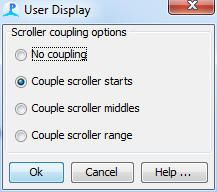Overview
User display panels are containers for other types of display window.
Each User Display panel will appear as a new tab on the PAMGuard GUI and can contain multiple display windows.

Currently supported standard display windows that can be incorporated into a display panel are:
Spectrogram displays
‘Radar’ displays
Maps
Time based displays
Several other PAMGuard modules may also create display windows which can be shown in a user display panel. The display menu will automatically show these additional displays when they are available.
Creating an instance of the user display
From the File>Add module menu, or from the pop-up menu on the data model display select “User Display Panel”. Enter a name for the new display panel (e.g. spectrograms, Ishmael data, etc) and press Ok.
Adding display windows to the user display
To add display windows to the user display, from the User Display menu select either New Spectrogram?, New Radar Display? etc.
Window Layout
Individual display windows may be dragged and resized in the normal way. Alternatively, you may use the options in the User Display>Arrange Windows sub menu.
The positions of windows will be remembered when you exit PAMGuard.
Scroller Coupling
Many display components, such as spectrograms, the map and time based displays contain a scroller which can be used to move back and forth through data, particularly when using PAMGuard Viewer mode to review previously analysed data.
Rules for scroller coupling are set from the User Display / Scroller Coupling menu:

No Coupling: Scrollers will not be coupled and can be moved independently.
Couple scroller starts: Start times of scrollers will follow each other.
Couple scroller middles: Middle / centre times of scrollers will follow each other.
Couple scroller range: Scrollers will maintain overlap, but more more independently.